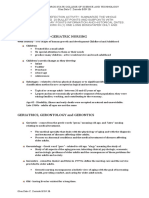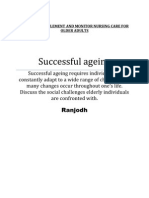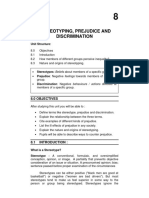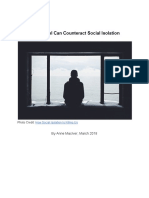Ageism in The United States
Ageism in The United States
Uploaded by
Mia MyoCopyright:
Available Formats
Ageism in The United States
Ageism in The United States
Uploaded by
Mia MyoOriginal Description:
Original Title
Copyright
Available Formats
Share this document
Did you find this document useful?
Is this content inappropriate?
Copyright:
Available Formats
Ageism in The United States
Ageism in The United States
Uploaded by
Mia MyoCopyright:
Available Formats
Ageism in the United States
Ageism in the United States
Samantha Jimenez
California State University, Fresno
SWRK 125
Barbara Foster, MSW
April 15, 2016
1
Ageism in the United States
Ageism has a wide array of different definitions and interpretations. It can be looked
upon as being the ultimate prejudice and the cruelest rejection. My interpretation of Ageism is
best described as a way to make someone feel uncomfortable, left out, insecure, made fun of or
better yet bullied and put down based on an individuals age. I would say the best definition of
ageism is said by the creator of the term ageism himself, Robert Butler. Robert Butler stated back
in the 1960s that Ageism is defined as being A process of systematic stereotyping of and
discrimination against people because they are old, just as racism and sexism accomplish this
with skin color and gender. Old people are categorized as senile, rigid in thought and manner,
old-fashioned in morality and skills. Ageism allows the younger generations to see older people
as different from themselves; thus they subtly cease to identify themselves with their elders as
human beings. Ageism is something that can be experienced on the personal, social, economic,
and institutional level. Ageism has become more predominant in the workforce as well as there
are more individuals in the U.S. living longer and working longer. Ageism in the United States is
a social attitude and may be passed from one individual to another and one generation to the
next. Some people may say that we dont necessarily see ageism as a type of prejudice although
it is just like sexism and racism because we are so use to it. Our society already has a
predisposition on ageism and certain stereotypes and beliefs are in a sense already programmed
into our culture and society as a whole. Americans may allow and engage in this negative
prejudice because they may be doing it unknowingly or knowingly but there are ways to fight it
and prevent it in the U.S.
Ageism in the United States
There are several different types of discrimination of ageism that are predominant here in
the United States. Different types of discrimination range from those of forced retirement and
elder abuse. Discrimination of ageism can occur at home, the store, the doctors, and even the
workforce. Common discriminations that individuals are already familiar with are: older adults
are say too old to continue to work, or physically incapable of completing certain tasks, weak
and or fragile, hard of hearing, cranky, and or oh this persons old what do you expect? Different
discriminations such as these make older adults feel incompetent and not good enough. It is not
fair to merely assume that older adults are not capable of doing things that individuals of other
ages are capable of doing. Another discrimination that older adults face is being too old to drive.
Once again, this stereotype is merely not true, older adults are fully capable of driving for as long
as theyd like just as long as they correspond with DMV protocols. Discrimination in the
workforce may include forcing older adults to retire at the age of 65 although they may not yet
be ready. Discrimination in the workforce may also include not hiring an individual based on
their age because they have too much experience or because they dont fit in with the look of the
company etc. Doctors may discriminate against older patients by not caring or putting much
effort into diagnosing and treating older adults simply because they are older and more prone to
disease and ailments than individuals of younger age. Older adults may be discriminated against
in the store if they come across the anti-aging section and or the card section that jokes about
old age. Lastly, individuals can be discriminated against in their own homes either by family
members through neglect or abuse. Discrimination can be felt by older individuals in various
other ways and different areas of life. Discrimination can affect an older adult inside and out and
may even lead the individual into believing the stereotype to be true leading to depression and
isolation.
Ageism in the United States
Discrimination of ageism is created by our culture; we live it, see it, and maybe even
practice it every day but may be unaware of it. Ageism is perpetuated by individuals of all ages
and in a various amounts of ways. We may not know it but discrimination against age can be
instilled in us even in our earliest years. Ageism can even be found in the media. There are
different commercials on anti-aging products and creams, even certain television shows portray
ageism. Ageism is something that our culture is against yet there are so many outlets that
encourage it. It is everywhere and we may even have different views and beliefs about older
adults that are not true. We have these certain negative beliefs about older adults that stems from
our very own society. Most Americans are prejudiced against elders in various ways. This is
shown by the results of various studies that have consistently found that most of those tested
believe the following erroneous stereotypes: Many aged live in nursing home; most of aged are
unable to adapt to change, are bored, are lonely, live alone, live in poverty, are often irritated and
angry; the aged have more injuries than younger persons, and the aged have higher rates of
criminal victimization (Palmore, 1998). Ageism in our culture is something that we cannot
escape but it is something that we can prevent from doing ourselves and participating in as long
as there is awareness about it. Ageism needs to be stopped especially in the United States where
there should be more support and understanding of a growing population of people. As a society
we need to change how we view older adults and stop discrimination and prejudice against such
a dominant group of people. Although ageism can be found in all groups of ages it is found
mostly against older adults. The sad part about it is that one day younger adults will become the
group of older adults the group that they be ageist against and be stereotypical against that is if
theyre lucky. So what is sickening as a culture is we discriminate against a group in which we
all become and it is a viscous cycle. As a country we need to come together to stop this type of
Ageism in the United States
discrimination and work together to find the root of the origin of ageism and put a stop to
perpetuating it.
Since older adults are subject to ageism so often they eventually may start to internalize
the beliefs and stereotypes and start to believe in it as being true and found. Older adults may get
too hard on themselves and may eventually feel terrible about themselves and their age. Through
these new beliefs and ideas about themselves individuals may be affected in different areas of
life. Older adults can be affected financially as they may spend more and more money on antiaging products or on different things in order to feel young again. Older adults can be affected
socially; they may become socially withdrawn or may participate in social behaviors that may
negatively affect their health such as drinking and smoking. Their health may also be impacted
mentally through depression and isolation. Older individuals may become too depressed after
internalizing all of these stereotypes that they might stop doing the things they love, they may
stop being an active member of society, and may withdrawal from taking care of their health
which may result in an earlier death. Ageism puts the overall health and well-being of older
adults at risk whether it is personal or institutionalized. Age prejudice is one of the most
socially condoned, institutionalized forms of prejudice in the worldespecially in the United
Statestoday. For example, there is a whole industry in the greeting card business built around
the over the hill theme. Such cards are often portrayed as humorous, but the essential message
is that it is undesirable to get older (Nelson, 2002). Ageism is and has been established and is
predominant in the United States it has become our custom to naturally discriminate against
older adults. As was stated by Nelson, there is a whole industry that participates in ageism every
day with the production of new cards and new jokes about older adults and age. This goes to
show that ageism is institutionalized in the United States as much as it is internalized. If ageism
Ageism in the United States
wasnt so institutionalized and our custom then maybe older adults wouldnt feel the need to
internalize these stereotypes and discriminations and that would lead to a better all-around
society.
Ageism should be combatted by each and every individual in the United States and the
society as a whole. In order for society as a whole to combat ageism it does start with the
individual. In order to prevent the spread of ageism among person to person and generation to
generation it must start with the individual putting a stop to it and standing up for what is right.
In order for the individual to combat ageism individuals should try to obtain further knowledge
about the aging generation by taking classes of such nature or researching articles and new about
the aging population. All of this knowledge would help individuals abstain from participating in
ageism discriminations as they would be aware and know what such discriminations are. In order
to combat it even further on the individual level one must abstain from using and saying ageist
terms about older adults. One should also try to avoid such language about older adults that
would suggest ageism; such as saying youth is vitality and old is sickness, and old people
shouldnt drive and so forth. All of this should be done on the individual level and recognizing
ageism and putting a stop to it will help the society as a whole to also combat against ageism.
Individuals can join together on the organizational level and participate in meetings that intend to
stop ageism and bring awareness to it. People can also try to get petitions to try to encourage
better enforcement of current laws against ageism. A lot of things can be done in order to combat
ageism. It all starts with the individual and in turn the society comes together in order to prevent
ageism and stop people from engaging in ageism acts. Discrimination based on age needs to stop
and the best way to put a stop to it involves a lot of other steps and actions. Ageism is still a bit
fresher in our society although it has been around for a while. Older adults deserve just as much
Ageism in the United States
respect as any other age and judging and assuming someone is a certain way, thinks a certain
way, or acts a certain way just because of their age is just wrong. Ageism and stereotypes needs
to stop and I believe we can stop it and work together as a whole in order to combat it and to
prevent future generations from discrimination.
Ageism in the United States
Nelson, T. Ageism: Stereotyping and Prejudice Against Older Persons. (2002). Cambridge, MA: MIT
Press.
Palmore, E. (1999). Ageism: Negative and Positive. New York: Springer Pub.
Payne, M. (2012). Citizenship Social Work with Older People. Chicago: Lyceum Books.
Disabled World. (2012-09-12). <a href="http://www.disabled-world.com/editorials/ageism.php">The Issue
of Ageism in America Today. Retrieved 2016-04-15, from http://www.disabledworld.com/editorials/ageism.php
Palmore, E. (2015). Ageism comes of age. Journals of Gerontology Series B-psychological Sciences and
Social Sciences, 70(6), 873-875.
Nelson, T. (2016). The age of ageism. Journal of Social Issues, 72(1), 191-198.
You might also like
- Ageism PowerpointDocument11 pagesAgeism Powerpointapi-254132646No ratings yet
- Aging Myths and Facts PowerPointDocument50 pagesAging Myths and Facts PowerPointangayarkanni100% (1)
- Ageism and Dislike For Older People - Cause and SolutionsDocument14 pagesAgeism and Dislike For Older People - Cause and SolutionsfencenbolonNo ratings yet
- Age Discrimination - WeeblyDocument3 pagesAge Discrimination - Weeblyapi-665977388No ratings yet
- Attitude Towards The Elderly in The Modern WorldDocument2 pagesAttitude Towards The Elderly in The Modern Worldrnld0% (1)
- Ageing Myth RealityDocument57 pagesAgeing Myth RealityvabcunhaNo ratings yet
- AgeismDocument6 pagesAgeismjennyhanyongNo ratings yet
- Work2 For WebsiteDocument5 pagesWork2 For Websiteapi-406713873No ratings yet
- A - Week 5 - Ageism (2016 - 09 - 25 18 - 04 - 03 Utc)Document12 pagesA - Week 5 - Ageism (2016 - 09 - 25 18 - 04 - 03 Utc)KalaNo ratings yet
- AGEISMDocument12 pagesAGEISMKalaNo ratings yet
- AgeismDocument3 pagesAgeismapi-317650829No ratings yet
- Ageing Myth RealityDocument44 pagesAgeing Myth RealityVijaya RaniNo ratings yet
- Unit 10 - Social Perspectives - Task 2 - XtraDocument18 pagesUnit 10 - Social Perspectives - Task 2 - Xtrazxko24No ratings yet
- 0, Agesim & Myths and Facts About Older AdultsDocument27 pages0, Agesim & Myths and Facts About Older AdultsMusharaf IqbalNo ratings yet
- Historical Perspective On The Study of Aging - BASA, ULAHDocument29 pagesHistorical Perspective On The Study of Aging - BASA, ULAHDebayn Candidato100% (1)
- Facts or Myth AgingDocument2 pagesFacts or Myth AgingJustine PlazaNo ratings yet
- BSN3B Zerrudo Introduction To Geriatric NursingDocument3 pagesBSN3B Zerrudo Introduction To Geriatric NursingGlen DaleNo ratings yet
- 433 Perspective of Aging PaperDocument5 pages433 Perspective of Aging PaperKesh KeshNo ratings yet
- Cause and Effect of StereotypingDocument4 pagesCause and Effect of StereotypingNur HelmyNo ratings yet
- Counseling AgedDocument26 pagesCounseling AgedSalima HabeebNo ratings yet
- AgeismDocument5 pagesAgeismapi-550568986No ratings yet
- Social Pychology 3Document6 pagesSocial Pychology 3Anu AbrahamNo ratings yet
- Ageism EssayDocument5 pagesAgeism EssaySKYEGRANTNo ratings yet
- Aging Myths and Facts PowerpointDocument50 pagesAging Myths and Facts PowerpointLatasha WilderNo ratings yet
- Mount Up With Wings: The Journey of Acceptance And Finding Purpose For Autistic AdultsFrom EverandMount Up With Wings: The Journey of Acceptance And Finding Purpose For Autistic AdultsNo ratings yet
- 8T1 AssemblyDocument25 pages8T1 Assemblykhaqan674No ratings yet
- Ucsp Gender InequalityDocument3 pagesUcsp Gender InequalityEme RoseNo ratings yet
- Aging in the Twenty-First Century: An American CrisisFrom EverandAging in the Twenty-First Century: An American CrisisNo ratings yet
- Term Paper OF Mpob: Age Discrimination atDocument25 pagesTerm Paper OF Mpob: Age Discrimination atSapna ChoudharyNo ratings yet
- The Complete Guide to Caring for Aging Parents: A Practical Handbook for Ensuring Their Well-being and Your Peace of MindFrom EverandThe Complete Guide to Caring for Aging Parents: A Practical Handbook for Ensuring Their Well-being and Your Peace of MindNo ratings yet
- Articles On StereotypesDocument15 pagesArticles On StereotypesSalwa Awang AkbarNo ratings yet
- 1st Asm Soc4328Document2 pages1st Asm Soc4328niceber1227No ratings yet
- Successful Ageing EssayDocument8 pagesSuccessful Ageing EssayRicky Jatt100% (1)
- Stereotyping DiscriminationDocument7 pagesStereotyping DiscriminationBaby CrimNo ratings yet
- Age (Chapter 12)Document63 pagesAge (Chapter 12)Audra GreenNo ratings yet
- Medical Terminology in GeriatricsDocument22 pagesMedical Terminology in GeriatricssajidaNo ratings yet
- Abhinya Research 6210new WordDocument76 pagesAbhinya Research 6210new Wordakhilbinu9766No ratings yet
- TH07 Stereotyping and PrejudiceDocument15 pagesTH07 Stereotyping and PrejudiceGiGi AdvinculaNo ratings yet
- Stereotyping, Prejudice, and Discrimination: The Effect of Group Based Expectations On Moral FunctioningDocument31 pagesStereotyping, Prejudice, and Discrimination: The Effect of Group Based Expectations On Moral Functioningirish xNo ratings yet
- Suggest Ways To Address Social Inequalities G 5Document16 pagesSuggest Ways To Address Social Inequalities G 5Ronald PurigayNo ratings yet
- Research ExampleDocument33 pagesResearch ExampleCharolet LuquiaNo ratings yet
- Hidden Bias - A PrimerDocument6 pagesHidden Bias - A PrimerVangie Castro100% (1)
- Guide Initiating A Conversation About AgeismDocument19 pagesGuide Initiating A Conversation About AgeismAna LeiteNo ratings yet
- Cor 002 Persuasive EssayDocument2 pagesCor 002 Persuasive EssayGian PelenioNo ratings yet
- Ucsp Q2 Week 5 - 20241102 - 224334 - 0000 1Document8 pagesUcsp Q2 Week 5 - 20241102 - 224334 - 0000 1sonnykarpov7No ratings yet
- GENDER DISCRIMINATION: Discrimination of Gender Is The Intellectual and Tangible LimitDocument45 pagesGENDER DISCRIMINATION: Discrimination of Gender Is The Intellectual and Tangible LimitsrinivasNo ratings yet
- Aging and ElderlyDocument3 pagesAging and ElderlyROXY STATUSNo ratings yet
- Old Age Consists of Ages Nearing or Surpassing The Average Life Span of HumanDocument13 pagesOld Age Consists of Ages Nearing or Surpassing The Average Life Span of HumanVarun JainNo ratings yet
- Chapter 13 PsychDocument2 pagesChapter 13 Psychkelemadu.15No ratings yet
- PTMF Pattern - Male SuicideDocument8 pagesPTMF Pattern - Male SuicideallmyinternetshereNo ratings yet
- Ageism The Myth of Growing OldDocument10 pagesAgeism The Myth of Growing OldSherrie D. LarchNo ratings yet
- Gender Stereotypes and Gender Discrimination - NOTESDocument5 pagesGender Stereotypes and Gender Discrimination - NOTESdeepikagupta1190No ratings yet
- Aissa England - Mla Typed Final EssayDocument8 pagesAissa England - Mla Typed Final Essayapi-719798160No ratings yet
- Primer Aug 2013Document5 pagesPrimer Aug 2013karloncha4385No ratings yet
- English Term PaperDocument14 pagesEnglish Term PaperLouise Mikhaela Rose EscarrillaNo ratings yet
- Research PaperDocument10 pagesResearch Paperapi-338660702No ratings yet
- PrejudiceDocument13 pagesPrejudiceshokor khanNo ratings yet
- Raising Teens Isn't Easy: Victor BarnesDocument19 pagesRaising Teens Isn't Easy: Victor BarnesCharmanne PatrianaNo ratings yet
- How Travel Can Counteract Social IsolationDocument31 pagesHow Travel Can Counteract Social IsolationAnne MacIverNo ratings yet



























































